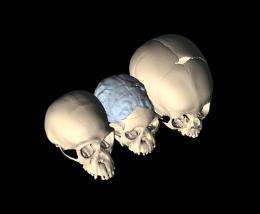Anthropologist finds explanation for hominin brain evolution in famous fossil

(�鶹��Ժ) -- One of the world’s most important fossils has a story to tell about the brain evolution of modern humans and their ancestors, according to Florida State University evolutionary anthropologist Dean Falk.
The Taung fossil — the first australopithecine ever discovered — has two significant features that were analyzed by Falk and a group of anthropological researchers. Their findings, which suggest brain evolution was a result of a complex set of interrelated dynamics in childbirth among new bipeds, were published May 7 in the Proceedings of the National Academy of Sciences.
“These findings are significant because they provide a highly plausible explanation as to why the hominin brain might grow larger and more complex,” Falk said.
The first feature is a “persistent metopic suture,” or unfused seam, in the frontal bone, which allows a baby’s skull to be pliable during childbirth as it squeezes through the birth canal. In great apes — gorillas, orangutans and chimpanzees — the metopic suture closes shortly after birth. In humans, it does not fuse until around 2 years of age to accommodate rapid brain growth.
The second feature is the fossil’s endocast, or imprint of the outside surface of the brain transferred to the inside of the skull. The endocast allows researchers to examine the brain’s form and structure.
After examining the Taung fossil, as well as huge numbers of skulls belonging to apes and humans, as well as corresponding 3-D CT (three-dimensional computed tomographic) scans, and taking into account the fossil record for the past 3 million years, Falk and her colleagues noted three important findings: The persistent metopic suture is an adaptation for giving birth to babies with larger brains; is related to the shift to a rapidly growing brain after birth; and may be related to expansion in the frontal lobes.
“The persistent metopic suture, an advanced trait, probably occurred in conjunction with refining the ability to walk on two legs,” Falk said. “The ability to walk upright caused an obstretric dilemma. Childbirth became more difficult because the shape of the birth canal became constricted while the size of the brainincreased. The persistent metopic suture contributes to an evolutionary solution to this dilemma.”
The later fusion of the metopic suture is most likely an adaptation of hominins who walked upright to be able to more easily give birth to babies with relatively large brains. The unfused seam is also related to the shift to rapidly growing brains after birth, an advanced human-like feature as compared to apes.
“The later fusion was also associated with evolutionary expansion of the frontallobes, which is evident from the endocasts of australopithecines such as Taung,” Falk said.
The Taung fossil, which is estimated to be around 21Ž2 million years old, was discovered in 1924 in Taung, South Africa. It became the “type specimen,” or main model, of the genus Australopithecus africanus when it was announced in 1925.
An australopithecine is any species of the extinct genera Australopithecus or Paranthropus that lived in Africa, walked on two legs and had relatively small brains.
Falk conducted the research with Marcia S. Ponce de Leon, Christoph P.E. Zollikofer and Naoki Morimoto of the Anthropological Institute and Museum at the University of Zurich in Switzerland.
More information: “The metopic suture of Taung (Australopithecus africanus) and its implications for hominin brain evolution,” by Dean Falk et al. PNAS (2012)
Journal information: Proceedings of the National Academy of Sciences
Provided by Florida State University



















